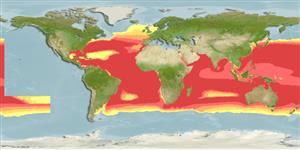Environment: milieu / climate zone / depth range / distribution range
Ecologia
marinhas; oceanódromo (Ref. 51243). Subtropical
Central Atlantic: Southwards to South Africa in the eastern part. Records outside central western Atlantic should be different species (H.Ho, pers.comm. 2/2017).
All reports in the Mediterranean Sea before 2017 are misidentifications for Bregmaceros nectabanus Whitley, 1941.
Tamanho / Peso / Idade
Maturity: Lm ? range ? - ? cm
Max length : 7.8 cm TL macho/indeterminado; (Ref. 40727); common length : 6.0 cm SL macho/indeterminado; (Ref. 47377)
Descrição suscinta
Chaves de identificação | Morfologia | Morfometria
Espinhos dorsais (total) : 0; Raios dorsais (total) : 48 - 57; Espinhos anais: 0; Raios anais : 49 - 60; Vértebras: 49 - 57. The head is of moderate size; eyes large; snout rounded. The first dorsal fin is well separated from the second dorsal fin. The body is brownish above, silvery below.
Generally oceanic. Feed on zooplankton and phytoplankton, especially crustaceans (Ref. 6735). Oviparous, with planktonic eggs and larvae (Ref. 6735).
Ciclo de vida ou comportamento de acasalamento
Maturities | Reprodução | Spawnings | Egg(s) | Fecundities | Larvas
Cohen, D.M., 1990. Bregmacerotidae. p. 524-525. In J.C. Quero, J.C. Hureau, C. Karrer, A. Post and L. Saldanha (eds.) Check-list of the fishes of the eastern tropical Atlantic (CLOFETA). JNICT, Lisbon; SEI, Paris; and UNESCO, Paris. Vol. 2. (Ref. 4496)
Status na Lista Vermelha da UICN (Ref. 130435)
Ameaça para os humanos
Harmless
Uso pelos humanos
Ferramentas
Relatórios especiais
Baixar XML
Fontes da internet
Estimates based on models
Preferred temperature (Ref.
123201): 15.1 - 27.6, mean 22.4 °C (based on 1483 cells).
Índice de diversidade filogenética (Ref.
82804): PD
50 = 0.5001 [Uniqueness, from 0.5 = low to 2.0 = high].
Bayesian length-weight: a=0.00380 (0.00187 - 0.00772), b=3.19 (3.00 - 3.38), in cm total length, based on LWR estimates for this species & (Sub)family-body (Ref.
93245).
Nível Trófico (Ref.
69278): 2.8 ±0.24 se; based on food items.
Fishing Vulnerability (Ref.
59153): Low vulnerability (10 of 100).
